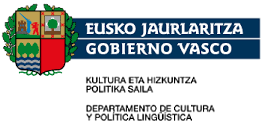Dokumentuaren akzioak
Oteizaren Apostularen Soka Dantza: Arantzazu Oteiza Tribute
Jorge Oteiza Enbil was born in 1908, and a century later his birth was marked with a special tribute highlighted by a dance choreographed by dance master Juan Antonio Urbeltz. The day appropriately was appropriately staged in front of the Basilica of Arantzazu. Sixty years ago when the current basilica church was built (this pilgrimage site dates back centuries) it was adorned with Oteiza's stone sculptures that he called "Apostoluak."
Urbeltz took that as inspiration to re-contextualize some traditional Basque dances. Members from the Basque Country dance groups Argia, Duguna and Kezka performed the Soka-dantza of Gipuzkoa, and Oñati's Oñatz group performed their unique Korpus dantzak.

PHOTOS:
See Maitane Algarra's online collection of
photos
VIDEO:
Gipuzkoako Soka-dantza (flv) segment of the Apostoluen
Dantza (Jexux Larrea)
SOURCE:
www.dantzan.com/blogak/duguna/apostoluekin-dantzan (photos &
video)
 |
< Jorge
Oteiza Enbil
|

Garikoitz Otamendi. To
see the video of this dance click on
Gipuzkoako Soka-dantza (flv)
|
Juan Antonio Urbeltz > |
 |

Oteiza's Apostoluak (the
Apostles) stone sculptures on the Monastery church of Arantzazu
PHOTOS: See Maitane
Algarra's online collection of
photos
VIDEO:
Gipuzkoako Soka-dantza (flv) segment of the Apostoluen
Dantza (Jexux Larrea)
SOURCE:
www.dantzan.com/blogak/duguna/apostoluekin-dantzan (photos &
video)

A moment from the "Martxa" by
the Oñatz group of Oñati.

A moment from the "Banakoa" by
the Oñatz group of Oñati, which lies downhill a few miles.

"Arku dantza" by the group Oñatz.
|
The Sanctuary of Arantzazu> (A’rant-sah-sue) is a centuries-old Franciscan sanctuary located in Oñati, Gipuzkoa. A pre-eminent landmark of popular belief. The place benefits from the highland silence and peaceful atmosphere of the Aizkorri mountain range making it then and now a popular destination for pilgrims and tourists. It's located in the site where presumably Mary, the mother of Jesus, appeared to the shepherd Rodrigo de Balanzategui in 1468. This manifestation was termed the Virgin of Arantzazu (there are numerous variations throughout the Basque Country, e.g., Itziar, Begona). Legend has it, the wooden figure of the Virgin was in a thorn-bush, and his exclamation "Arantzan zu?!" (Thou, among the thorns?!) gave rise to the name of the place. According to the linguistic explanation, the name stems from "arantza + zu", 'place abounding in hawthorn'. Arantzazu can be found as a Basque female name (e.g., Arantza, Arantzazu, Arantxa. The place is also a starting point for several mountains trails. |
|

In this moment of the Apostoluen
Dantza, the men assume the pose of Oteiza's
sculptured figures on the facade of the Arantzazu
basilica.

Though it
did not debut that day in Arantzazu, Urbeltz's vision
included the "Apostoluak" (based on those in
the Corpus Christi procession of Onati) coming to life. A year
later for the 2009 show of "Axuri beltza" it was
presented.

PHOTOS: See Maitane
Algarra's online collection of
photos
VIDEO:
Gipuzkoako Soka-dantza (flv) segment of the Apostoluen
Dantza (Jexux Larrea)
SOURCE:
www.dantzan.com/blogak/duguna/apostoluekin-dantzan (photos &
video)
Dokumentuaren akzioak







